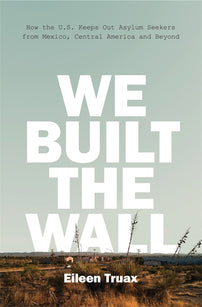We Built the Wall
U.S. immigration policy during the Trump presidency and in the years beyond could be outrageous and appalling, but it’s not new.

A revised extract from Eileen Truax’s We Built the Wall: How the US Keeps Out Asylum Seekers from Mexico, Central America and Beyond, translated by Diane Stockwell (coming out June 19, 2018). See all our forthcoming Autumn publishing here.
For decades, the United States has promoted itself to the rest of the world as a democratic country, with a policy of open arms and affirming diversity, which has very little to do with how the nation actually shapes its policies around immigration, refuge, and asylum. In spite of being the country with the largest number of immigrants in the world—almost 50 million people living in U.S. territory were not born there—the United States has a smaller percentage of immigrants in relation to the general population than other countries. Immigrants comprise 14 percent of the U.S. population, compared with 22 percent in Canada and 28 percent in Australia.
As with most countries that receive immigrants, the current demographic composition of the United States is the result of the government’s application of immigration policy based on the country’s economic and workplace needs. But it is also a function of the alliances and shifting sands of international politics. In terms of refuge and asylum policy, and the methods for detaining and processing immigrants, the predominant principles have more to do with political, and even partisan, criteria, not human rights or social justice. The United States opens its arms to whoever benefits it economically at the moment, and to asylum and refuge seekers who can demonstrate persecution or a threat to their safety or their lives, as long as they come from countries with governments viewed as questionable by the United States.
One hallmark of Donald Trump’s presidential campaign was connecting anti-terrorist and national security rhetoric with migration. In addition to justifying measures like the “Muslim ban,” such connections encompassed building a border wall, accusing Mexicans of being drug dealers and rapists, and claiming without evidence that undocumented people vote illegally; these last two assertions reinforced his promise to deport 11 million undocumented people from the country.
Although talking about Trump as a dangerous threat to immigrants has been a good strategy for media outlets trying to increase their online traffic, the so-called “deportation machine” has already been up and running for at least a decade, beginning with the George W. Bush administration in 2001 in the wake of the 9/11 terrorist attacks, and picking up steam during Barack Obama’s time in office. Almost 3 million people were deported in the eight years of Obama’s presidency—a number that Trump has provided as a possible goal for his administration. And the criteria in place for granting refuge or asylum were established fifty years ago, initially based on international humanitarian goals but implemented in the service of convenience and political interests.
U.S. immigration policy during the Trump presidency and in the years beyond could be outrageous and appalling, but it’s not new. Most Americans have refused to acknowledge that the immigrant community has endured discrimination and a hostile environment for decades. Tax dollars paid by U.S. residents are spent to lock up immigrants, re-victimizing those who have already been victimized in their home countries, who have reached out to “the best democracy in the world” in an attempt to save their own lives. We rarely think about the new arrivals who have had to leave everything behind and come here as a last resort, arriving in a new land only to be labeled “the other,” the foreigner, and whose lives depend on accepting this description. From the comfort of our own secure legal status, we have already built the Wall.
This is a revised extract from Eileen Truax’s We Built the Wall: How the US Keeps Out Asylum Seekers from Mexico, Central America and Beyond, translated by Diane Stockwell (coming out June 19, 2018). See all our forthcoming Autumn books, and more preview extracts, here!.
[book-strip index="1" style="buy"]